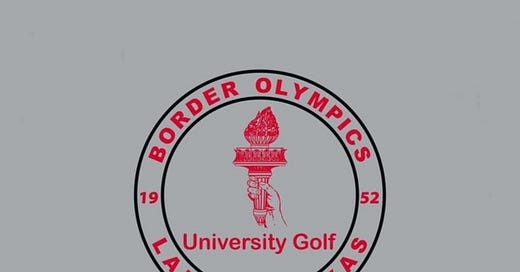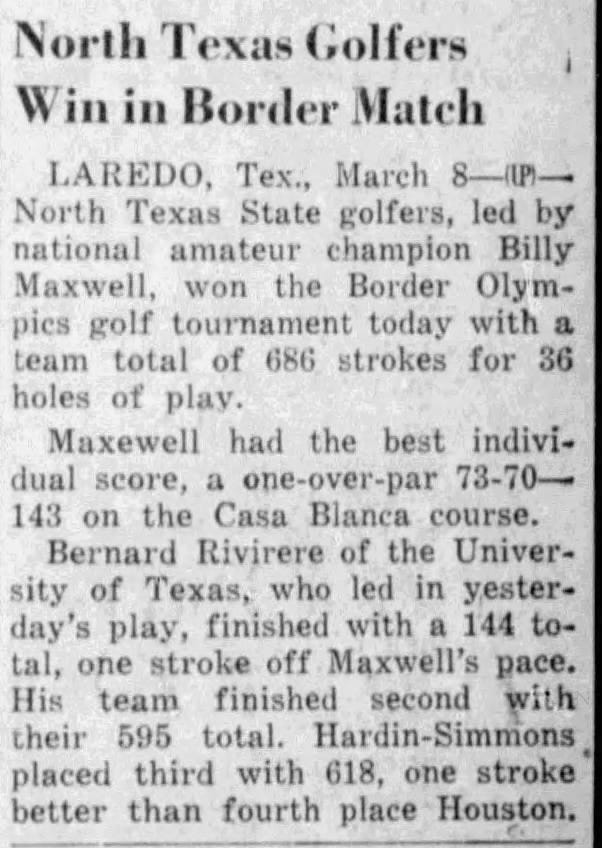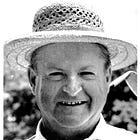Historic Tournaments: Border Olympics
The Longest Continuously Running Collegiate Golf Tournament
BORDER OLYMPICS: THE LONGEST CONTINUOUSLY RUNNING COLLEGIATE GOLF TOURNAMENT
Thousands of different tournaments have been played throughout college golf’s long history. Given the challenges of money, time, weather, and course availability, any tournament that runs more than a handful of times would be considered a huge success by any measure. The ones that have lasted across decades are labeled as historic and usually come with their own unique flair steeped in tradition. One such tournament that undoubtedly has earned that moniker is the “Border Olympics”, held annually in Laredo, TX.
Although started 5 years after the Western Intercollegiate (1947), 11 years after the first Women’s Intercollegiate Championship (1941), and 55 years after the Men’s Intercollegiate Golf Championships began (1897), the Border Olympics (1952) now boasts the title of the longest continuously running collegiate golf tournament in the country. Of the short list of tournaments that have history extending as far back as the 1980s, most have had at least a couple of gap years for various reasons. Few have been able to successfully dodge complete rainouts and even fewer were fortunate enough to have been held prior to the unexpected cancellation of the 2019-20 season. Now being played for the 73rd time (Feb 19-20, 2024) in as many years, the Border Olympics is truly a historic tournament.

TOURNAMENT CREATION
The town of Laredo, Texas sits on the border of the United States and Mexico on the north bank of the Rio Grande. As an important hub for trade between the two countries, Laredo is the third most populated U.S. city on the Mexican border, behind San Diego and El Paso.
Besides trade, Laredo is perhaps most well-known for the annual George Washington Birthday Celebration (WBCA). Dating back to 1898, the WBCA is a month-long event held each February that today draws in around 400,000 people from both the U.S. and Mexico. In 1932, a subgroup of the WBCA committee - known as the Olympics Committee - created a series of five track meets known as the International Frontier Olympics. The event was an international affair, bringing together high school and college athletes from Texas and Mexico. This track meet became so popular and significant that an entire (non-profit) organization was created, called the Border Olympics, which split off the event from the WBCA and began holding it in early March.
The event would continue to grow, adding multiple other sporting events including the golf tournament discussed here (1952), a tennis tournament (1976), and various other high school events for baseball (1987), girl’s track and field (1989), and softball (2002).
FIRST TOURNAMENT [1952]
Twenty years after the first track meet, a college golf tournament was added to the annual Border Olympics event. For simplicity, from here on out in this post “Border Olympics” just refers to the golf component.
It started out as a small affair headlined by the three-time defending NCAA golf champion North Texas State College (NTSC, now known as the University of North Texas) who would come out on top of this first Border Olympics on their way to a fourth straight NCAA title. NTSC’s Coach Cobb was apparently instrumental in not only getting the tournament off the ground, but also ensuring it would be an ongoing event by committing his team’s annual attendance. Also in this first Border Olympics was a University of Texas team that was regularly dominating the Southwestern Conference, Hardin-Simons University, and the University of Houston with a new part-time coach named Dave Williams.
Billy Maxwell, the reigning US Amateur champ and key member of the vaunted NTSC championship teams, took individual honors. He completed the 36 holes at Casa Blanca golf course at one-over par 143, winning by a single stroke. The team scoring wasn’t as close as NTSC’s 10-over par 586 (misprinted below) beat out Texas by 9 shots.
A SUDDEN TRAGIC LOSS [1954]
The third annual Border Olympics, held in 1954, was notable for a few reasons. Already it was growing in prominence, the field increased to include other Southwestern teams such as an up-in-coming Oklahoma A&M (now known as Oklahoma State), Rice, Texas A&M, Baylor, and Trinity.
NTSC, winner of the first two tournaments, came from behind in the second (and final) round to tie with Oklahoma A&M for team honors. OK A&M’s Joe Walser held on to claim a one-stroke victory over NTSC’s Ray Ferguson, making Walser the first non-NTSC player to win individual honors in the tournament.
Three days after the tournament, NTSC’s Hall of Fame Coach Fred Cobb unexpectedly passed away following a major heart attack. He was only 55 and seemingly at the peak of his career. To say it was a devastating blow to all of college golf would be an understatement.
Read more about Coach Cobb and North Texas State’s success here:
THE ERA OF HOUSTON DOMINATION [1955-1985]
With heavy hearts following the tragic loss of Coach Cobb, one of the people instrumental in starting and growing the event, the Border Olympics continued as planned the next year. In fact, it would continue to grow in prominence the following decades as teams from the region grew to be national contenders, making the tournament an early-Spring proving ground ahead of the NCAA championships in May-June.
Houston, led by Coach Dave Williams who became known as “Mr. College Golf”, earned their first Border Olympics championship in 1955 and would cap off the year with their first NCAA title. Throughout the 1950s-1970s, Houston battled legendary teams from the region including Texas, Oklahoma State, and Texas A&M. The list of team and individual Border Olympics winners reads like an honor roll of NCAA championship contenders, and indeed several players have awards from both events adorning their trophy case.
Coach Williams took to heart many of the things the Border Olympics did to make the tournament both competitive and interesting for players and spectators alike, and applied many of those principles for his own event - the All-American Intercollegiate Invitational (AAII) - which started a few years after that first Border Olympics victory in 1955. He secured his final Border Olympics victory in 1985 and, as he had done 15 other times in the last 30 years, capped off the year with an NCAA championship. Altogether, Coach Williams-led Houston teams earned 21 Border Olympics victories before his retirement in 1987.
Read more about Coach William’s historic career here:
CHANGE TO LAREDO CC [1984-PRESENT]
Other than one year in the 1950s, the Border Olympics was played at Casa Blanca Golf Course until 1984. Since that time, Laredo Country Club has served as an exception host and challenge for some of the best college golfers in the country.
Today, the tournament remains as one of the top early Spring events, drawing in teams throughout Texas, Louisiana, Arkansas, and surrounding states.


THE STREAK CONTINUES
Generally speaking, the tournament has been blessed with good weather and has only had a few rounds cancelled completely due to rain (2016 and 2017). One of the closest calls the tournament has had with possibly interrupting the streak was when the COVID pandemic cancelled remainder of 2019-20 season just a few weeks after the 2020 edition played in late-February.
As stated on the tournament’s official website by long time Tournament Director (35 years!!) F.C. “Pancho” Averill Jr:
Great weather, great fields of competition on a great course and the touch of Laredo hospitality have made for great tournaments over the years. “At this time of the year, many northern schools have not made it out to play at home due to weather conditions so coming to Laredo where they get to see great teams from many different conferences makes this tournament grand.”
Top golf programs and golf coaches nationwide are familiar with The Border Olympics University Golf Tournament and are excited to come to Laredo and participate.
We wish the Border Olympics many more years of success!









